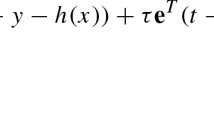Abstract
The nonlinear complementarity problem is cast as an unconstrained minimization problem that is obtained from an augmented Lagrangian formulation. The dimensionality of the unconstrained problem is the same as that of the original problem, and the penalty parameter need only be greater than one. Another feature of the unconstrained problem is that it has global minima of zero at precisely all the solution points of the complementarity problem without any monotonicity assumption. If the mapping of the complementarity problem is differentiable, then so is the objective of the unconstrained problem, and its gradient vanishes at all solution points of the complementarity problem. Under assumptions of nondegeneracy and linear independence of gradients of active constraints at a complementarity problem solution, the corresponding global unconstrained minimum point is locally unique. A Wolfe dual to a standard constrained optimization problem associated with the nonlinear complementarity problem is also formulated under a monotonicity and differentiability assumption. Most of the standard duality results are established even though the underlying constrained optimization problem may be nonconvex. Preliminary numerical tests on two small nonmonotone problems from the published literature converged to degenerate or nondegenerate solutions from all attempted starting points in 7 to 28 steps of a BFGS quasi-Newton method for unconstrained optimization.
Similar content being viewed by others
References
G. Auchmuty, “Variational principles for variational inequalities,”Numerical Functional Analysis and Optimization 10 (1989) 863–874.
D.P. Bertsekas,Constrained Optimization and Lagrange Multiplier Methods (Academic Press, New York, 1982).
R.W. Cottle, “Nonlinear programs with positively bounded Jacobians,” ORC64-12(RR) Operations Research Center, University of California (Berkeley, CA, 1964).
R.W. Cottle, “Nonlinear programs with positively bounded Jacobians,”Journal of SIAM on Applied Mathematics 14 (1966) 147–158.
G.B. Dantzig and R.W. Cottle, “Positive (semi-)definite programming,” in: J. Abadie, ed.,Nonlinear Programming (North-Holland, Amsterdam, 1967) pp. 55–73.
J.E. Dennis and R.B. Schnabel,Numerical Methods for Unconstrained Optimization and Nonlinear Equations (Prentice-Hall, Englewood Cliffs, NJ, 1983).
G. Di Pillo and L. Grippo, “An exact penalty function method with global convergence properties for nonlinear programming problems,”Mathematical Programming 36 (1986) 1–18.
G. Di Pillo and L. Grippo, “Exact penalty functions in constrained optimization,”SIAM Journal on Control and Optimization 27 (1989) 1333–1360.
A.V. Fiacco and G.P. McCormick,Nonlinear Programming: Sequential Unconstrained Minimization Techniques (Wiley, New York, 1968).
M. Fukushima, “Equivalent differentiable optimization problems and descent methods for asymmetric variational inequality problems,”Mathematical Programming 53 (1992) 99–110.
S.-P. Han and O.L. Mangasarian, “Exact penalty functions in nonlinear programming,”Mathematical Programming 17 (1979) 251–269.
P.T. Harker and J.-S. Pang, “Finite-dimensional variational inequality and nonlinear complementarity problems: A survey of theory, algorithms and applications,”Mathematical Programming (Series B) 48 (1990) 161–220.
P.T. Harker and B. Xiao, “Newton's method for the nonlinear complementarity problem: A B-differentiable equation approach,”Mathematical Programming (Series B) 48 (1990) 339–357.
N.H. Josephy, “Newton's method for generalized equations,” Technical Summary Report 1965, Mathematics Research Center, University of Wisconsin (Madison, WI, 1979).
S. Karamardian, “The nonlinear complementarity problem with applications, Parts 1 and 2,”Journal of Optimization Theory and Applications 4 (1969) 87–98 and 167–181.
M. Kojima and S. Shindo, “Extensions of Newton and quasi-Newton methods to systems of PC1 equations,”Journal of Operations Research Society of Japan 29 (1986) 352–374.
Z.-Q. Luo and P. Tseng, “Error bound and reduced gradient projection algorithms for convex minimization over polyhedral sets,”SIAM Journal on Optimization 3 (1993) 43–59.
Z.-Q. Luo and P. Tseng, “Error bound and convergence analysis of matrix splitting algorithms for the affine variational inequality problem,”SIAM Journal on Optimization 2 (1992) 43–54.
O.L. Mangasarian,Nonlinear Programming (McGraw-Hill, New York, 1969).
O.L. Mangasarian, “Equivalece of the complementarity problem to a system of nonlinear equations,”SIAM Journal on Applied Mathematics 31 (1976) 89–92.
O.L. Mangasarian, “Unconstrained methods in nonlinear programming,” in:Nonlinear Programming. SIAM-AMS Proceedings, Vol. IX (American Mathematical Society, Providence, RI, 1976) pp. 169–184.
O.L. Mangasarian, “Global error bounds for monotone affine variational inequality problems,”Linear Algebra and its Applications 174 (1992) 153–163.
O.L. Mangasarian and T.-H. Shiau, “Error bounds for monotone linear complementarity problems,”Mathematical Programming 36 (1986) 81–89.
O.L. Mangasarian and T.-H. Shiau, “Lipschitz continuity of solutions of linear inequalities, programs and complementarity problems,”SIAM Journal on Control and Optimization 25 (1987) 583–595.
B. Murtagh and M. Saunders, “MINOS 5.0 user's guide,” Technical Report SOL83.20, Systems Optimization Laboratory, Stanford University (Stanford, CA, 1983).
J.M. Ortega,Numerical Analysis: A Second Course (Academic Press, New York, 1972).
J.-S. Pang, “Newton's method for B-differentiable equations,”Mathematics of Operations Research 15 (1990) 311–341.
J.-S. Pang, “A B-differentiable equation based, globally and locally quadratically convergent algorithm for nonlinear programs, complementarity and variational inequality problems,”Mathematical Programming 51 (1991) 101–131.
J.-S. Pang and S.A. Gabriel, “NE/SQP: A robust algorithm for the nonlinear complementarity problem,”Mathematical Programming 60 (1993) 295–337.
R.T. Rockafellar, “The multiplier method of Hestenes and Powell applied to convex programming,”Journal of Optimization Theory and Applications 12 (1973) 555–562.
P.K. Subramanian, “Gauss—Newton methods for the complementarity problem,” to appear in:Journal of Optimization Theory and Applications.
P. Wolfe, “A duality theorem for nonlinear programming,”Quarterly of Applied Mathematics 19 (1961) 239–244.
Z.Q. Luo, O.L. Mangasarian, J. Ren and M.V. Solodov, “New error bounds for the linear complementarity problem,” to appear in:Mathematics of Operations Research.
J. Ren, “Computable error bounds in mathematical programming,” Ph.D. Dissertation, Computer Sciences Department, University of Wisconsin (Madison, WI, July 1993).
Author information
Authors and Affiliations
Additional information
Dedicated to Phil Wolfe on his 65th birthday, in appreciation of his major contributions to mathematical programming.
This material is based on research supported by Air Force Office of Scientific Research Grant AFOSR-89-0410 and National Science Foundation Grant CCR-9101801.
Rights and permissions
About this article
Cite this article
Mangasarian, O.L., Solodov, M.V. Nonlinear complementarity as unconstrained and constrained minimization. Mathematical Programming 62, 277–297 (1993). https://doi.org/10.1007/BF01585171
Received:
Revised:
Issue Date:
DOI: https://doi.org/10.1007/BF01585171




